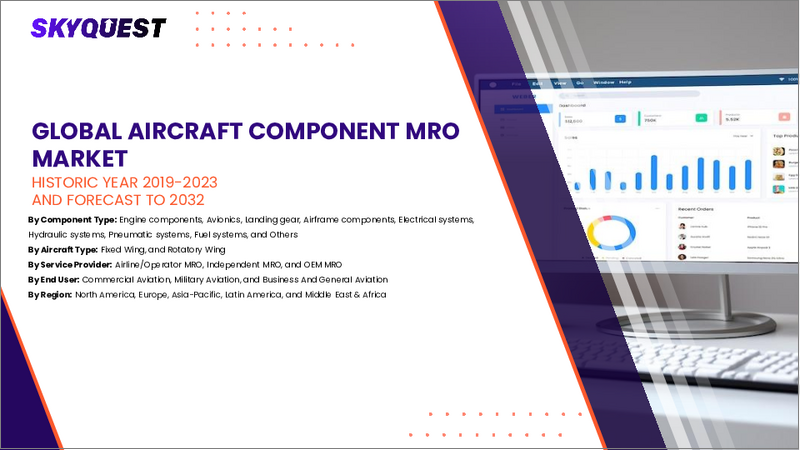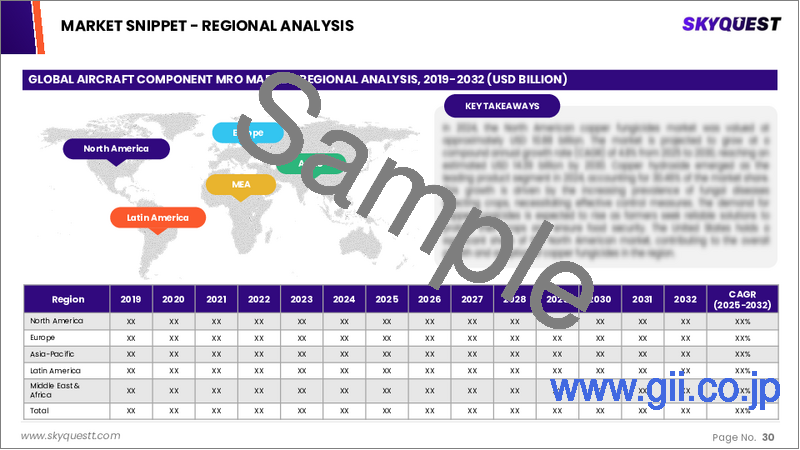|
|
市場調査レポート
商品コード
1777304
航空機部品MRO市場規模、シェア、成長分析、コンポーネントタイプ別、航空機の種類別、サービスプロバイダーの種類別、最終用途別、地域別 - 産業予測、2025年~2032年Aircraft Component MRO Market Size, Share, and Growth Analysis, By Component Type (Engine components, Avionics), By Aircraft Type (Turboprops, Turbo shafts), By Service Provider Type, By End Use, By Region - Industry Forecast 2025-2032 |
||||||
|
|||||||
| 航空機部品MRO市場規模、シェア、成長分析、コンポーネントタイプ別、航空機の種類別、サービスプロバイダーの種類別、最終用途別、地域別 - 産業予測、2025年~2032年 |
|
出版日: 2025年07月19日
発行: SkyQuest
ページ情報: 英文 178 Pages
納期: 3~5営業日
|
全表示
- 概要
- 目次
航空機部品MROの世界市場規模は2023年に192億米ドルとなり、予測期間(2025-2032年)のCAGRは8.1%で、2024年の207億6,000万米ドルから2032年には387億米ドルに成長する見通しです。
世界の航空機部品MRO市場は、航空機の老朽化、厳しい安全規制、費用対効果の高いメンテナンスソリューションの追求などの要因によって力強い成長を遂げています。飛行頻度の増加は、より大きな磨耗と損傷をもたらし、高度なメンテナンスの実践を必要とします。航空会社はMRO戦略を活用して航空機の寿命を延ばし、コストのかかる機材更新を回避しています。規制の圧力は厳しい整備スケジュールの遵守を義務付け、MROセクターをさらに刺激しています。AI、機械学習、IoT、拡張現実(AR)、仮想現実(VR)の採用により、市場は変革期を迎えています。これらの技術は、予知保全を可能にし、MROチームの意思決定を強化し、リアルタイムのデータ統合を通じて効率を向上させ、最終的にはダウンタイムを削減し、保全業務におけるリソース配分を最適化します。
目次
イントロダクション
- 調査の目的
- 調査範囲
- 定義
調査手法
- 情報調達
- 二次と一次データの方法
- 市場規模予測
- 市場の前提条件と制限
エグゼクティブサマリー
- 世界市場の見通し
- 供給と需要の動向分析
- セグメント別機会分析
市場力学と見通し
- 市場概要
- 市場規模
- 市場力学
- 促進要因と機会
- 抑制要因と課題
- ポーターの分析
主な市場の考察
- 重要成功要因
- 競合の程度
- 主な投資機会
- 市場エコシステム
- 市場の魅力指数(2024年)
- PESTEL分析
- マクロ経済指標
- バリューチェーン分析
- 価格分析
- 技術分析
- ケーススタディ
- 顧客購買行動分析
航空機部品MRO市場規模:コンポーネントタイプ別& CAGR(2025-2032)
- 市場概要
- エンジン部品
- 航空電子機器
- 着陸装置
- 機体部品
- 電気システム
- 油圧システム
- 空気圧システム
- 燃料システム
- その他
航空機部品MRO市場規模:航空機の種類別& CAGR(2025-2032)
- 市場概要
- ターボプロップ機
- ターボシャフト
- ターボジェット
- ターボファン
- ナローボディ
- ワイドボディ
- リージョナルジェット
- その他
航空機部品MRO市場規模:サービスプロバイダーの種類別& CAGR(2025-2032)
- 市場概要
- OEM
- 航空会社(社内MRO)
- サードパーティのMROプロバイダー(独立)
- 軍事MROユニット
航空機部品MRO市場規模:最終用途別& CAGR(2025-2032)
- 市場概要
- 民間航空
- 軍事航空
航空機部品MRO市場規模:地域別& CAGR(2025-2032)
- 北米
- 米国
- カナダ
- 欧州
- ドイツ
- スペイン
- フランス
- 英国
- イタリア
- その他欧州地域
- アジア太平洋地域
- 中国
- インド
- 日本
- 韓国
- その他アジア太平洋地域
- ラテンアメリカ
- ブラジル
- その他ラテンアメリカ地域
- 中東・アフリカ
- GCC諸国
- 南アフリカ
- その他中東・アフリカ
競合情報
- 上位5社の比較
- 主要企業の市場ポジショニング(2024年)
- 主な市場企業が採用した戦略
- 最近の市場動向
- 企業の市場シェア分析(2024年)
- 主要企業の企業プロファイル
- 企業の詳細
- 製品ポートフォリオ分析
- 企業のセグメント別シェア分析
- 収益の前年比比較(2022-2024年)
主要企業プロファイル
- Lufthansa Technik AG
- GE Aviation
- ST Engineering Aerospace
- SIA Engineering Company
- AAR Corp
- Delta TechOps
- HAECO Group
- AFI KLM E&M
- Honeywell Aerospace
- MTU Aero Engines AG
- Safran Aircraft Engines
- Pratt & Whitney
- FL Technics
- Turkish Technic
結論と提言
Global Aircraft Component MRO Market size was valued at USD 19.2 billion in 2023 and is poised to grow from USD 20.76 billion in 2024 to USD 38.7 billion by 2032, growing at a CAGR of 8.1% during the forecast period (2025-2032).
The global aircraft component MRO market is experiencing robust growth driven by factors such as the ageing fleet, stringent safety regulations, and the pursuit of cost-effective maintenance solutions. Increased flight frequencies lead to greater wear and tear, necessitating advanced maintenance practices. Airlines leverage MRO strategies to prolong aircraft lifespan, avoiding the costly process of fleet replacement. Regulatory pressures mandate adherence to strict maintenance schedules, further stimulating the MRO sector. The market is undergoing a transformation with the adoption of AI, machine learning, IoT, augmented reality, and virtual reality. These technologies enable predictive maintenance, enhance decision-making for MRO teams, and improve efficiency through real-time data integration, ultimately reducing downtime and optimizing resource allocation in maintenance operations.
Top-down and bottom-up approaches were used to estimate and validate the size of the Global Aircraft Component MRO market and to estimate the size of various other dependent submarkets. The research methodology used to estimate the market size includes the following details: The key players in the market were identified through secondary research, and their market shares in the respective regions were determined through primary and secondary research. This entire procedure includes the study of the annual and financial reports of the top market players and extensive interviews for key insights from industry leaders such as CEOs, VPs, directors, and marketing executives. All percentage shares split, and breakdowns were determined using secondary sources and verified through Primary sources. All possible parameters that affect the markets covered in this research study have been accounted for, viewed in extensive detail, verified through primary research, and analyzed to get the final quantitative and qualitative data.
Global Aircraft Component MRO Market Segments Analysis
Global Aircraft Component MRO Market is segmented by Component Type, Aircraft Type, Service Provider Type, End Use and region. Based on Component Type, the market is segmented into Engine components, Avionics, Landing gear, Airframe components, Electrical systems, Hydraulic systems, Pneumatic systems, Fuel systems and Others. Based on Aircraft Type, the market is segmented into Turboprops, Turbo shafts, Turbo jet and Turbo fan. Based on Service Provider Type, the market is segmented into OEMs, Airlines (In-house MRO), Third-party MRO providers (Independent) and Military MRO units. Based on End Use, the market is segmented into Civil aviation and Military aviation. Based on region, the market is segmented into North America, Europe, Asia Pacific, Latin America and Middle East & Africa.
Driver of the Global Aircraft Component MRO Market
The Global Aircraft Component MRO market is significantly driven by airlines and operators striving to minimize downtime and control expenses. The adoption of predictive maintenance has emerged as a vital strategy, facilitating real-time data collection and analytics that empower operators to optimize maintenance scheduling. By anticipating issues before they escalate, this approach ensures the timely replacement of critical components. Furthermore, predictive maintenance contributes to cost savings by enabling prompt repairs of essential systems like engines, brakes, and landing gears, which would incur substantial costs if failures were to occur. Thus, the focus on enhancing operational efficiency and cost management continues to propel market growth.
Restraints in the Global Aircraft Component MRO Market
The global aircraft component Maintenance, Repair, and Overhaul (MRO) market faces significant constraints due to the complex and multifaceted regulatory environment within the aviation industry. This sector is subject to a myriad of international, national, and regional regulations that enforce strict standards for safety, quality, and performance for all aircraft components. Meeting these compliance requirements necessitates a high level of specialized administrative and technical expertise, leading to substantial investments in training and compliance management. As a result, the burdensome nature of these obligations can impede the growth and operational efficiency of MRO providers within the industry.
Market Trends of the Global Aircraft Component MRO Market
The Global Aircraft Component MRO market is experiencing a notable shift towards the use of advanced lightweight materials, driven by manufacturers' priorities for fuel efficiency, reduced emissions, and improved structural performance. This trend towards sustainability is compelling MRO providers to adapt by developing expertise in advanced composite repair capabilities, thereby gaining a competitive edge. The integration of these innovative materials is not only reshaping existing maintenance practices but also fostering opportunities for specialization within the MRO ecosystem. As airlines increasingly demand eco-friendly solutions, the market is expected to thrive, emphasizing the need for MRO providers to stay ahead of technological advancements and material adaptations.
Table of Contents
Introduction
- Objectives of the Study
- Scope of the Report
- Definitions
Research Methodology
- Information Procurement
- Secondary & Primary Data Methods
- Market Size Estimation
- Market Assumptions & Limitations
Executive Summary
- Global Market Outlook
- Supply & Demand Trend Analysis
- Segmental Opportunity Analysis
Market Dynamics & Outlook
- Market Overview
- Market Size
- Market Dynamics
- Drivers & Opportunities
- Restraints & Challenges
- Porters Analysis
- Competitive rivalry
- Threat of substitute
- Bargaining power of buyers
- Threat of new entrants
- Bargaining power of suppliers
Key Market Insights
- Key Success Factors
- Degree of Competition
- Top Investment Pockets
- Market Ecosystem
- Market Attractiveness Index, 2024
- PESTEL Analysis
- Macro-Economic Indicators
- Value Chain Analysis
- Pricing Analysis
- Technology Analysis
- Case Studies
- Customer Buying Behavior Analysis
Global Aircraft Component MRO Market Size by Component Type & CAGR (2025-2032)
- Market Overview
- Engine components
- Avionics
- Landing gear
- Airframe components
- Electrical systems
- Hydraulic systems
- Pneumatic systems
- Fuel systems
- Others
Global Aircraft Component MRO Market Size by Aircraft Type & CAGR (2025-2032)
- Market Overview
- Turboprops
- Turbo shafts
- Turbo jet
- Turbo fan
- Narrow-body
- Wide-body
- Regional jets
- Others
Global Aircraft Component MRO Market Size by Service Provider Type & CAGR (2025-2032)
- Market Overview
- OEMs
- Airlines (In-house MRO)
- Third-party MRO providers (Independent)
- Military MRO units
Global Aircraft Component MRO Market Size by End Use & CAGR (2025-2032)
- Market Overview
- Civil aviation
- Military aviation
Global Aircraft Component MRO Market Size & CAGR (2025-2032)
- North America (Component Type, Aircraft Type, Service Provider Type, End Use)
- US
- Canada
- Europe (Component Type, Aircraft Type, Service Provider Type, End Use)
- Germany
- Spain
- France
- UK
- Italy
- Rest of Europe
- Asia Pacific (Component Type, Aircraft Type, Service Provider Type, End Use)
- China
- India
- Japan
- South Korea
- Rest of Asia-Pacific
- Latin America (Component Type, Aircraft Type, Service Provider Type, End Use)
- Brazil
- Rest of Latin America
- Middle East & Africa (Component Type, Aircraft Type, Service Provider Type, End Use)
- GCC Countries
- South Africa
- Rest of Middle East & Africa
Competitive Intelligence
- Top 5 Player Comparison
- Market Positioning of Key Players, 2024
- Strategies Adopted by Key Market Players
- Recent Developments in the Market
- Company Market Share Analysis, 2024
- Company Profiles of All Key Players
- Company Details
- Product Portfolio Analysis
- Company's Segmental Share Analysis
- Revenue Y-O-Y Comparison (2022-2024)
Key Company Profiles
- Lufthansa Technik AG
- Company Overview
- Business Segment Overview
- Financial Updates
- Key Developments
- GE Aviation
- Company Overview
- Business Segment Overview
- Financial Updates
- Key Developments
- ST Engineering Aerospace
- Company Overview
- Business Segment Overview
- Financial Updates
- Key Developments
- SIA Engineering Company
- Company Overview
- Business Segment Overview
- Financial Updates
- Key Developments
- AAR Corp
- Company Overview
- Business Segment Overview
- Financial Updates
- Key Developments
- Delta TechOps
- Company Overview
- Business Segment Overview
- Financial Updates
- Key Developments
- HAECO Group
- Company Overview
- Business Segment Overview
- Financial Updates
- Key Developments
- AFI KLM E&M
- Company Overview
- Business Segment Overview
- Financial Updates
- Key Developments
- Honeywell Aerospace
- Company Overview
- Business Segment Overview
- Financial Updates
- Key Developments
- MTU Aero Engines AG
- Company Overview
- Business Segment Overview
- Financial Updates
- Key Developments
- Safran Aircraft Engines
- Company Overview
- Business Segment Overview
- Financial Updates
- Key Developments
- Pratt & Whitney
- Company Overview
- Business Segment Overview
- Financial Updates
- Key Developments
- FL Technics
- Company Overview
- Business Segment Overview
- Financial Updates
- Key Developments
- Turkish Technic
- Company Overview
- Business Segment Overview
- Financial Updates
- Key Developments





